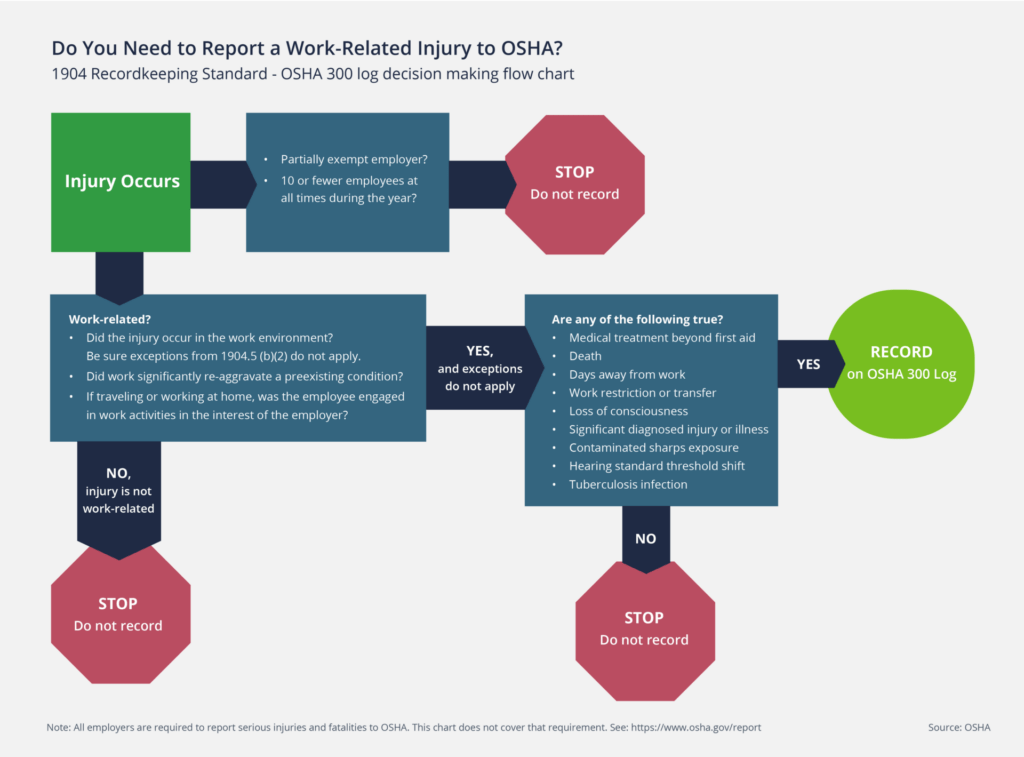Blog
OSHA 300 Logs: How to Determine Whether to Record an Injury or Illness
Employers with more than 10 employees at any time during a calendar year and who are not partially exempt must keep Occupational Safety and Health Administration (OSHA) 300 and 300 A logs of workplace injuries and illnesses. When keeping 300 logs and 300 A summary records, accuracy is essential—overreporting can result in unnecessary regulatory attention.

Accuracy in 300 log and 300 A recordkeeping can mean the difference between winning or losing a contract or having to submit a time-consuming corrective action plan related to an above-average recordable case rate, lost time case rate, or other OSHA statistic. Even if your company does not win or lose contracts based on OSHA statistics, these rates can still be important because high rates can put an employer on an OSHA enforcement programming target list or cause OSHA enforcement visits to expand and drag on longer than necessary. Another consideration is that OSHA requires employers to give employees, former employees, or employee representatives access to the 300 log. Having additional, non-recordable injuries recorded on the log is rarely a good thing.
|
Read Our Series of Articles on OSHA 300 Logs: |
Many times, the individual responsible for keeping accurate OSHA logs is not the same person who deals with contracts and new business. This often leads to a natural disconnect and potential for misunderstanding surrounding the competing interests of limiting the recordable cases to only those that are recordable by regulation and a desire to make sure that nothing is missed that should be on the 300 log. The key to balancing these two goals is accuracy as well as strategic planning. This article will concentrate on three steps that can help ensure only recordable cases end up on the 300 log.
A subsequent article in this series will address strategic planning and how an organization can legitimately seek to minimize OSHA rates by ensuring that medical care only occurs when it is needed and appropriate and by shoring up typical problem areas related to reporting delays and return to work processes.
Step 1: Determine If the Injury or Illness Is Work-Related
The first and most important question is whether or not the injury or illness in question is work-related. Standard 29 CFR 1904.5 deals with this topic. If it is not work-related, the case is not recordable and those keeping the log can simply stop here.
Many times, those keeping logs will skip past the question of work-relatedness and move straight to medical treatment and other triggers. Moving too quickly through this step can cause cases to end up on the log that do not belong there. One example would be a heart attack that occurs at work. An employee may lose consciousness, be admitted to the hospital, and ultimately die from a heart attack that occurs at work. All of the above outcomes would cause a case to be recordable, but only if an event at work contributed to the heart attack. The employer has to look at the facts and make a determination.
|
OSHA Example: Q: An employee is walking into work and collapses as a result of a heart attack. Is this a recordable case? A: If the employee has a preexisting condition (heart issues), the employer needs to make a determination on whether there was an event or exposure in the work environment that may have aggravated this illness. If it is determined the heart attack is solely the result of a non-work-related condition, the case need not be recorded on the OSHA Log. FAQ ID: 568Source: OSHA e-correspondence, Q&A section |
|
What if the workers’ compensation carrier deems the injury compensable? Even if the WC carrier determines a claim is work-related and compensable, it may not be work-related for OSHA log-keeping purposes. The opposite can be true as well. A companion article to this one examines whether all denied WC cases should be removed from the 300 log. That article lays the foundation for understanding the difference between the workers' compensation system and OSHA recordability regulations. |
In making a work-relatedness determination, OSHA states that injuries occurring in the physical workplace are presumed to be work-related, but they also provide employers with a list of injury and illness causations which, even if they occur at work, even if they are considered compensable via worker’s compensation statute, are not considered work-related for recordkeeping purposes and do not need to be put on the log. The list below can be found at 1904.5(b)(2).
OSHA states that you are not required to record injuries and illnesses if:
- At the time of the injury or illness, the employee was present in the work environment as a member of the general public rather than as an employee.
- The injury or illness involves signs or symptoms that surface at work but result solely from a non-work-related event or exposure that occurs outside the work environment.
- The injury or illness results solely from voluntary participation in a wellness program or in a medical, fitness, or recreational activity such as blood donation, physical examination, flu shot, exercise class, racquetball, or baseball.
- The injury or illness is solely the result of an employee eating, drinking, or preparing food or drink for personal consumption (whether bought on the employer's premises or brought in). For example, if the employee is injured by choking on a sandwich while in the employer's establishment, the case would not be considered work-related.
Note: If the employee is made ill by ingesting food contaminated by workplace contaminants (such as lead), or gets food poisoning from food supplied by the employer, the case would be considered work-related. - The injury or illness is solely the result of an employee doing personal tasks (unrelated to their employment) at the establishment outside of the employee's assigned working hours.
- The injury or illness is solely the result of personal grooming, self-medication for a non-work-related condition, or is intentionally self-inflicted.
- The injury or illness is caused by a motor vehicle accident and occurs on a company parking lot or company access road while the employee is commuting to or from work.
- The illness is the common cold or flu.
(Note: contagious diseases such as tuberculosis, brucellosis, hepatitis A, or plague are considered work-related if the employee is infected at work). - The illness is a mental illness. Mental illness will not be considered work-related unless the employee voluntarily provides the employer with an opinion from a physician or other licensed healthcare professional with appropriate training and experience (psychiatrist, psychologist, psychiatric nurse practitioner, etc.) stating that the employee has a mental illness that is work-related.
While the above list is helpful, it does have to be carefully applied. This fact was colorfully illustrated during the COVID-19 pandemic. Because COVID-19 was not considered the “common cold or flu” (point 8) by OSHA, employers were faced with utilizing the typical flow of determining if the case was work-related, medical treatment was given, time was lost from work, or work accommodations were given.
| The FAQ on OSHA’s recordkeeping page is a useful tool in helping make work-relatedness determinations. The fact that doing a search on the terms “work related” produces 85 FAQ answers and doing a search on the words "good faith" results in 10 FAQ answers illustrates just how detailed and nuanced questions around work relatedness can be. |
While not addressed in this article, other questions Standard 1904.5 addresses include:
- When a pre-existing condition has been “significantly re-aggravated” and become recordable.
- When an injury to a traveling employee might be considered recordable and when it would not.
- When a work-at-home employee's injury is considered work-related and when it is not.
Step 2: Determine If Medical Treatment Was Rendered
The second question to ask is whether medical treatment was rendered (Standard 29 CFR 1904.7). According to OSHA, first aid is not considered medical treatment regardless of who applies it. OSHA has a list of first aid treatments in 1904.7(b)(5)(ii) that is all inclusive. In other words, if the only treatments given are on this first aid list, the case is not recordable unless another trigger such as loss of consciousness, lost time, or another separately listed trigger occurs. This is true even if the first aid is rendered by a medical doctor or other healthcare professional.
An area of confusion can occur here when diagnostic procedures are performed. While not referenced in the first aid list, diagnostic procedures and even hospital-administered diagnostics or observation do not make a case recordable on their own. They are not considered medical treatment. A case of this type would only be recordable if another trigger occurs. Read through step 3 for additional discussion around additional triggers.
|
OSHA Examples: Q: Do x-rays make a case recordable? A: No. X-rays and other diagnostic procedures are not considered medical treatment and do not make a case recordable. FAQ ID: 254Source: OSHA e-correspondence, Q&A section
A: "Medical treatment" means the management and care of a patient to combat disease or disorder. For the purposes of Part 1904, medical treatment does not include: Visits to a physician or other licensed health care professional solely for observation or counseling; The conduct of diagnostic procedures, such as x-rays and blood tests, including the administration of prescription medications used solely for diagnostic purposes (e.g., eye drops to dilate pupils); or "First aid" as defined in paragraph (b)(5)(ii) of this section. FAQ ID: 436Source: 29 CFR 1904, Q&A section |
Step 3: Determine If Other Recordability Triggers Apply
If you determine that an injury is work-related but that medical treatment was not administered, there are a few additional triggers you need to rule out. If any of these triggering outcomes occur, the case is deemed recordable (Standard 29 CFR 1904.7).
- Death: A work-related death is always recordable.
- Days away from work: If an injury is work-related and results in days away from work, the case is always recordable. It should be noted that whether the physician or the employer makes the determination that the employee cannot work as a result of the injury, the days missed would be recorded as days away from work and the case would be recordable.
- Restricted work or transfer to another job: Work-related injuries that result in restricted duty are always recordable. For a case to qualify as a restricted duty case, the employer or physician must preclude an employee from performing one or more of their routine functions. OSHA defines routine functions as “work activities the employee regularly performs at least once per week.”
- Loss of consciousness: A work-related injury resulting in a loss consciousness is always recordable.
- A significant work-related injury or illness diagnosed by a physician or other licensed healthcare professional is always recordable. This includes work-related cases involving cancer, chronic irreversible disease, a fractured or cracked bone, or a punctured eardrum.
- Contaminated sharps exposure: Employers must record all work-related needlestick injuries and cuts from sharp objects that are contaminated with another person's blood or other potentially infectious material as defined by 29 CFR 1910.1030. In this case, the employee’s name is not recorded on the log.
- Work-related hearing standard threshold shifts, as defined by 29 CFR 1904.10, must be recorded on the 300 log.
- Work-related tuberculosis infections must be recorded on the 300 log.
The flow chart below can be used as a high-level guide to making a recordability decision.

Depending on the strategy being used by an employer and who has been keeping the OSHA logs, it is not uncommon to find multiple non-recordable entries on the logs. Many times, this is done with the best of motives. If, in reviewing your logs, you find yourself questioning some of the entries, reach out to your Woodruff Sawyer service team or Stephen Glazier directly with questions.
Author
Table of Contents












